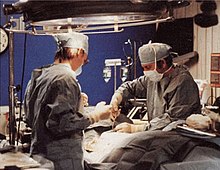
Back حفظ الخلايا الحية بالتبريد Arabic Крионика Bulgarian ক্রায়োনিক্স Bengali/Bangla Criònica Catalan Kryonika Czech Крионика CV Kryonik Danish Kryonik German Κρυογονική Greek Cryonics English

Krionika (dari bahasa Yunani κρύος kryos yang berarti 'dingin') adalah pembekuan suhu rendah (biasanya pada −196 °C (−320,8 °F; 77,1 K)) dari mayat manusia atau kepala yang terpenggal, dengan harapan resusitasi mungkin terjadi di masa depan.[1][2] Hal ini dianggap dengan skeptisisme dalam komunitas ilmiah arus utama dan telah secara luas dianggap sebagai praktik perdukunan.[3][4]
Prosedur krionika dapat dimulai hanya setelah kematian klinis, dan "pasien" krionika mati secara hukum. Prosedur krionika idealnya dimulai beberapa menit setelah kematian,[5] dan menggunakan krioprotektan untuk mencegah pembentukan es selama kriopreservasi.[6] Jenazah tidak mungkin dihidupkan kembali setelah menjalani vitrifikasi, yang menyebabkan kerusakan otak termasuk jaringan sarafnya.[7] Mayat pertama yang dibekukan adalah mayat Dr. James Bedford pada tahun 1967.[8] Pada tahun 2014, sekitar 250 mayat dilindungi oleh kriopreservasi di Amerika Serikat, dan 1.500 orang telah membuat pengaturan untuk menjalani kriopreservasi setelah kematian resmi mereka.[9]
Krionika dipandang dengan skeptis oleh komunitas ilmiah, karena kerusakan yang disebabkan oleh dingin pada sel, meskipun cryoprotectants. Pada tahun 2018, proses baru, vitrifiksasi, dikembangkan tetapi tidak memiliki konservasi ambang rangsangan sinaps. Oleh karena itu, pada tahun 2023, urgensinya adalah untuk mengarahkan penelitian ke arah konservasi ambang rangsangan sinapsis selama vitrifiksasi.[10] [11] [12] [13] [14][15][16][17][18][19]
- ^ McKie, Robin (13 July 2002). "Cold facts about cryonics". The Observer. Diakses tanggal 1 December 2013.
Cryonics, which began in the Sixties, is the freezing – usually in liquid nitrogen – of human beings who have been legally declared dead. The aim of this process is to keep such individuals in a state of refrigerated limbo so that it may become possible in the future to resuscitate them, cure them of the condition that killed them, and then restore them to functioning life in an era when medical science has triumphed over the activities of the Grim Reaper.
- ^ "Dying is the last thing anyone wants to do – so keep cool and carry on". The Guardian. 10 October 2015. Diakses tanggal 21 February 2016.
- ^ Butler K (1992). A Consumer's Guide to "Alternative" Medicine. Prometheus Books. hlm. 173.
- ^ Hoppe, Nils (2016-11-18). "Justice Cryogenically Delayed is Justice Denied?". BMJ Journal of Medical Ethics blog (dalam bahasa Inggris). Diakses tanggal 2019-06-24.
The mere fact that we feel the promises made by the cryopreservation industry amount to a most grievous form of quackery ...
; Zimmer, Carl; Hamilton, David (October 2007). "Could He Live to 2150?". Best Life.Quack watch: The following controversial treatments are all being touted as antiaging miracle cures.
; Harold Schechter (2 June 2009). The Whole Death Catalog: A Lively Guide to the Bitter End. Random House Publishing Group. hlm. 206. ISBN 978-0-345-51251-2.; Pein, Corey (2016-03-08). "Everybody Freeze!". The Baffler (dalam bahasa Inggris). Diakses tanggal 2019-06-24.; Chiasson, Dan (December 2014). "Heads Will Roll". Harper's Magazine. ISSN 0017-789X. Diakses tanggal 2019-06-24.; Miller, Laura (2012-06-24). ""The Mansion of Happiness": Matters of life and death". Salon (dalam bahasa Inggris). Diakses tanggal 2019-06-24.; Almond, Steve (2014-02-28). "Sparks of Life". The New York Times (dalam bahasa Inggris). ISSN 0362-4331. Diakses tanggal 2019-06-24.; Carroll, Robert Todd (2003). The Skeptics Dictionary: A Collection of Strange Beliefs, Amusing Deceptions, and Dangerous Delusions. Wiley. ISBN 0471272426.A business based on little more than hope for developments that can be imagined by science is quackery. There is little reason to believe that the promises of cryonics will ever be fulfilled.
- ^ Hendry, Robert; Crippen, David (2014). "Brian Failure and Brain Death". ACS Surgery: Principles and Practice critical care. Decker Intellectual Properties Inc. hlm. 1–10.
A physician will pronounce a patient using the usual cardiorespiratory criteria, whereupon the patient is legally dead. Following this pronouncement, the rules pertaining to procedures that can be performed change radically because the individual is no longer a living patient but a corpse. In the initial cryopreservation protocol, the subject is intubated and mechanically ventilated, and a highly efficient mechanical cardiopulmonary resuscitation device reestablishes circulation.
- ^ Best BP (April 2008). "Scientific justification of cryonics practice" (PDF). Rejuvenation Research. 11 (2): 493–503. doi:10.1089/rej.2008.0661. PMC 4733321
 . PMID 18321197.
. PMID 18321197.
- ^ Devlin, Hannah (18 November 2016). "The cryonics dilemma: will deep-frozen bodies be fit for new life?". The Guardian. Diakses tanggal 21 January 2019.
- ^ "Death To Dust: What Happens To Dead Bodies? 2nd Edition, Chapter 7: Souls On Ice".
- ^ Moen, OM (August 2015). "The case for cryonics". Journal of Medical Ethics. 41 (18): 493–503. doi:10.1136/medethics-2015-102715. PMID 25717141.
- ^ https://cmte.ieee.org/futuredirections/2018/05/08/jumping-into-the-void-vitrifixation/
- ^ https://www.fightaging.org/archives/2018/03/large-mammal-brain-preservation-prize-won-using-a-method-of-vitrifixation/
- ^ https://www.medicalnewstoday.com/articles/321235
- ^ https://www.basicthinking.de/blog/2018/03/20/wuerdet-ihr-euer-gehirn-in-der-cloud-speichern-lassen/
- ^ https://de.1in4mentalhealth.com/your-brain-could-be-backed-up-for-a-F5R
- ^ https://www.begeek.fr/une-start-up-promet-de-telecharger-votre-cerveau-dans-le-cloud-apres-votre-mort-267146
- ^ https://www.letemps.ch/economie/une-startup-americaine-promet-limmortalite-numerique
- ^ https://www.radiofrance.fr/franceinter/podcasts/c-est-deja-demain/une-start-up-americaine-veut-sauvegarder-notre-cerveau-2272910
- ^ https://cmte.ieee.org/futuredirections/2018/05/08/jumping-into-the-void-vitrifixation/
- ^ https://www.01net.com/actualites/cette-start-up-promet-de-telecharger-votre-cerveau-dans-le-cloud-apres-vous-avoir-ote-la-vie-1396344.html